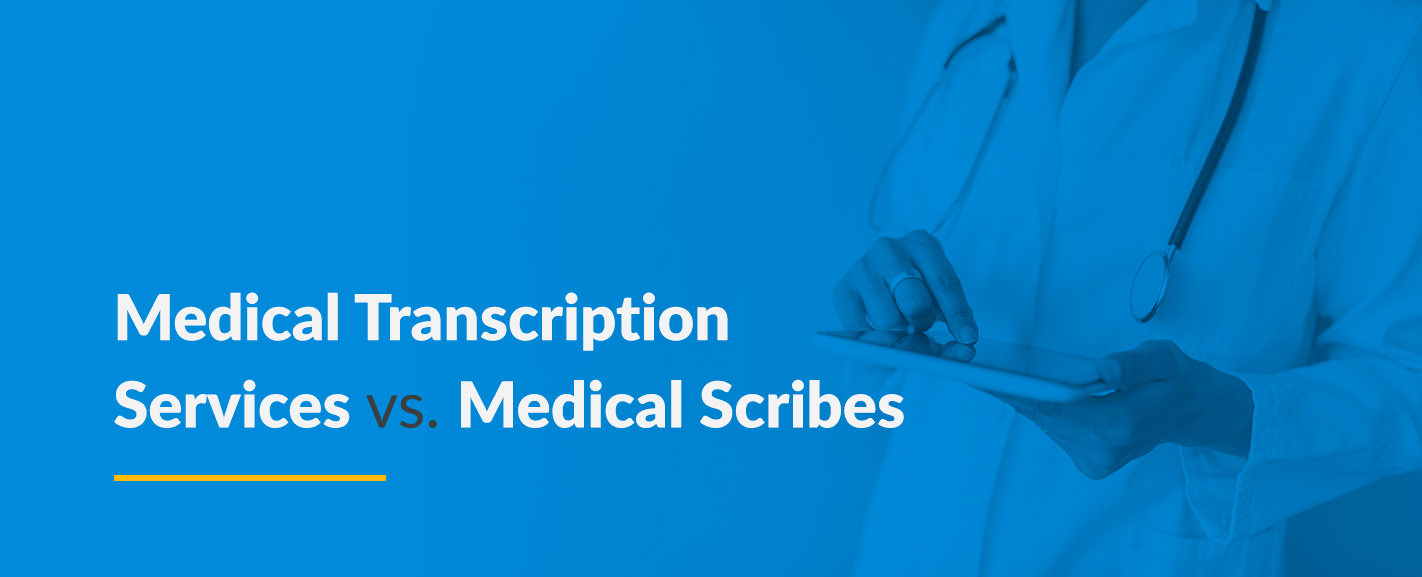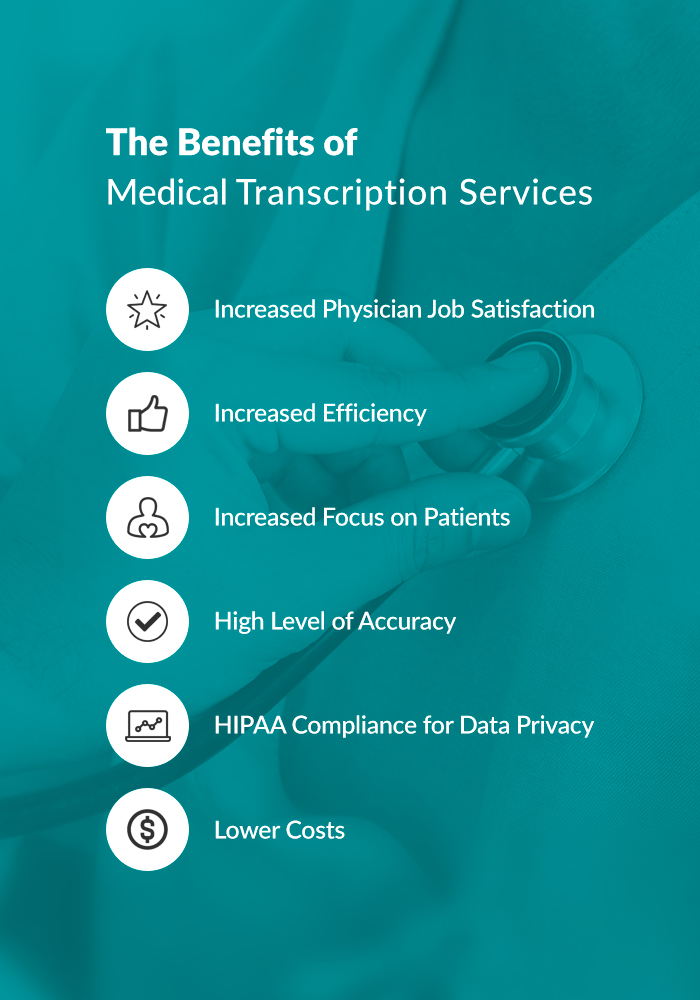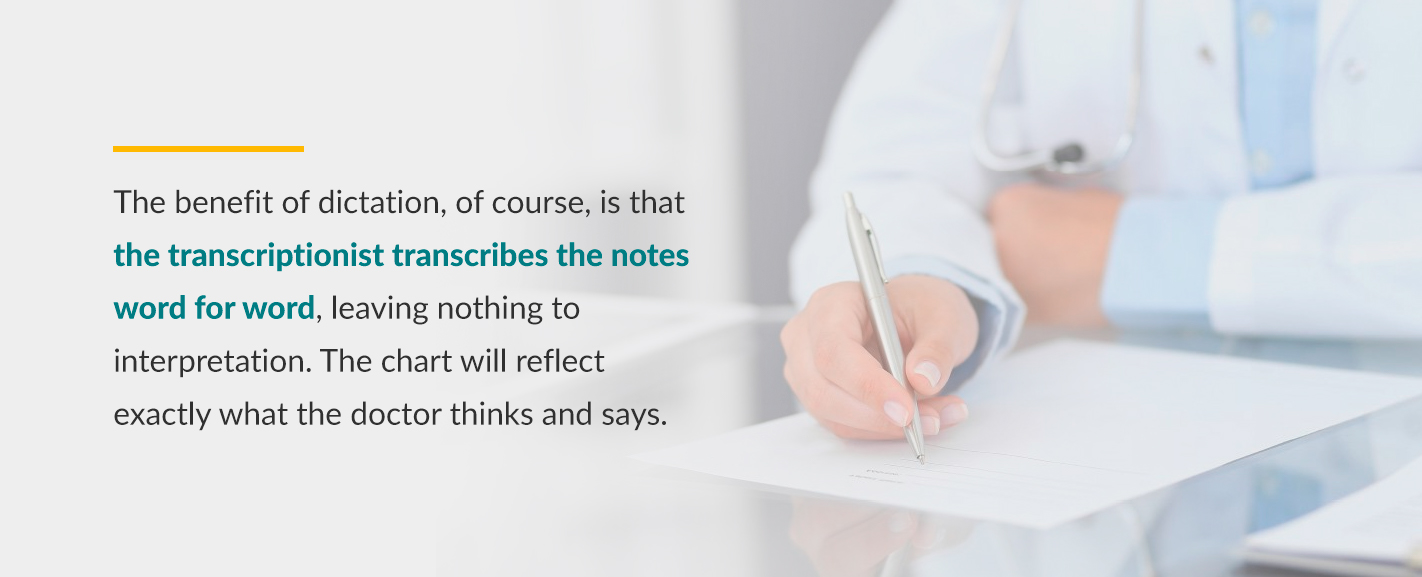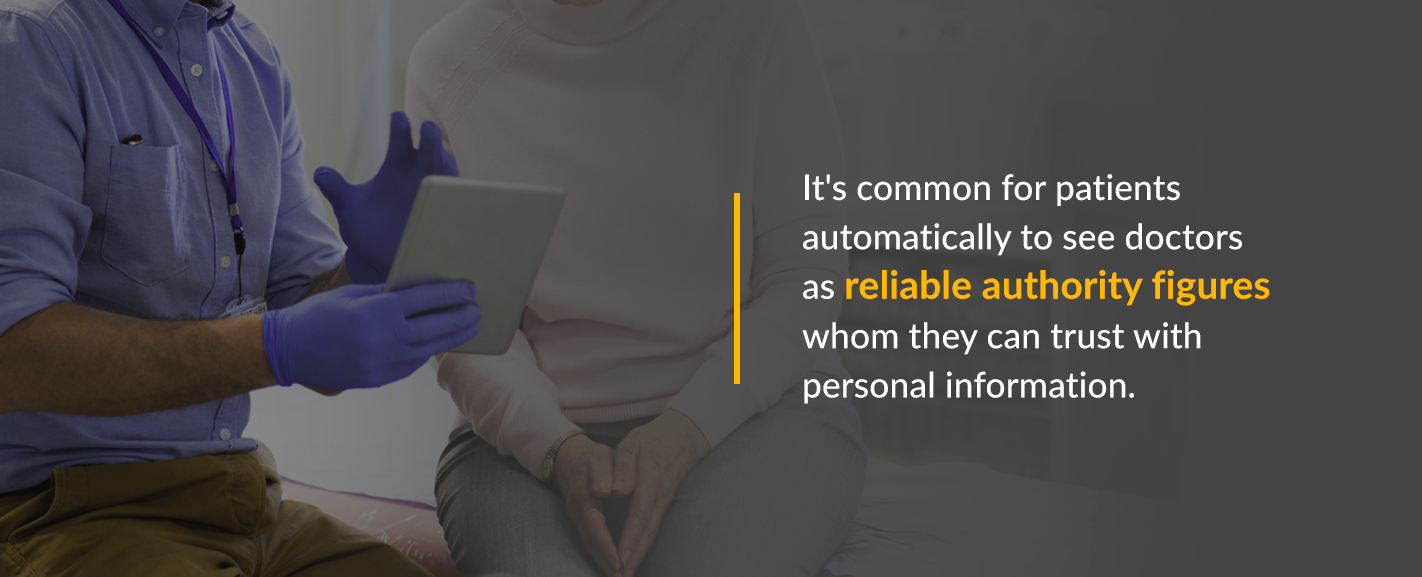Difference Between Medical Transcription Services and Medical Scribes: Which One is Right For You?
Nov 07, 2019 | Jonathan Maisel
Medical transcription services and medical scribe services, both in-house and outsourced, offers substantial benefits to the medical community. Especially with the widespread adoption of electronic health record (EHR) software, many practices have turned to either transcription or scribe services to make their workloads more manageable.
But what exactly are medical transcription services and medical scribes? And how can you choose which one is right for your practice? Below, we’ll offer some pros and cons to help make your decision easier and more thoroughly informed.

What Are The Benefits of Medical Transcription Services?
Medical transcription services work by using trained professionals to transcribe the audio files that contain physicians’ dictated notes on office visits, lab results and medical procedures. These services offer a wealth of benefits to health care professionals and their practices.
1. Increased Physician Job Satisfaction
Studies have shown that the use of EHRs contributes substantially to doctors’ job stress and eventual burnout. Increasingly, data entry for EHRs takes up much of physicians’ workdays. A recent study of almost 1,800 doctors in Rhode Island found that physicians who used EHRs in their practices experienced over twice the burnout rate of physicians who did not use EHRs. Additionally, 64% of doctors surveyed said that EHRs added to their daily frustration levels.
Medical transcription services dramatically reduce these issues by integrating their services seamlessly with EHRs. They thereby reduce the amount of tedious work that doctors and nurse practitioners must perform. By taking the bulk of data-entry transcription work out of practitioners’ hands, medical transcription services free doctors to perform the quality patient-care work that they went into medicine to do. This freedom lifts a weight from doctors’ shoulders and makes their jobs more enjoyable and fulfilling.
2. Increased Efficiency
The use of medical transcription services makes medical practices more efficient. The less time physicians spend doing desk work, the more time they have available for appointments. A higher number of appointments gets a higher volume of patients through the door, leading to a reduction in the time that patients must wait before they can see a doctor.
Using a medical transcription service also means that doctor’s offices won’t lose efficiency by getting bogged down in paperwork. Most medical transcription services offer speedy turnaround times, and these turnarounds mean that patient paperwork and claim filings can all get done faster.
3. Increased Focus on Patients
The corollary to the above two benefits is that medical transcription services puts the focus of patient care back on patients, rather than on paperwork. With time-consuming transcriptions done elsewhere, health care professionals can focus their energies on the human element of their work. They can be fully present with patients to listen to their concerns and consider them carefully. This level of care leads to more positive patient outcomes and a higher level of patient satisfaction and wellness.
4. High Level of Accuracy
Medical transcription services also employ rigorously trained professionals. As a result, the transcriptions produced are highly accurate and professionally polished.
Medical transcription services often use a quality control system in which a transcriptionist performs the work and then an editor checks the completed transcription for accuracy. This system allows for multiple sets of eyes to catch errors in the work.
5. HIPAA Compliance for Data Privacy
Reputable medical transcription services offer secure encryption and full compliance with HIPAA standards. These levels of security and compliance keep sensitive patient data confidential. When you use medical transcription services, you gain the peace of mind of knowing only trusted professionals will have access to confidential patient records.
6. Lower Costs
With transcription services, instead of paying a full salary and benefits, medical practices pay only for what they need, which is typically based on the volume of lines transcribed. Along with the increased income from seeing more patients faster, this convenient use-based payment structure leads to lower costs.
What Are The Benefits of Medical Scribes?
What is a certified medical scribe? Medical scribes are charting specialists who follow along with a physician throughout the day. Like other medical professionals, such as nurse practitioners and physician’s assistants, medical scribes are sometimes described as “physician extenders” because they increase physicians’ productivity. They take on the tasks that require lower amounts of human capital, such as clerical work, freeing physicians to perform the tasks that require higher amounts of human capital.
Simply put, medical scribes take notes on patient interviews, examinations and procedures. A scribe would also record the results of any testing reports received from the laboratory. Some additional benefits of using a medical scribe include:
1. Reduced Physician Overtime
Using scribes, especially in emergency rooms, substantially reduces the amount of physicians’ overtime. By completing patient charts while doctors are treating emergency cases, scribes make it possible for doctors to leave when their shifts are over. In the absence of scribes, doctors often have to stay after hours to finish their work.
2. Reduced Physician Burnout
The use of medical scribes eases the burden of charting work for doctors. As with medical transcription, medical scribes assume some of the clerical work of the practice, making it possible for doctors to concentrate on patient care and diagnosis.
Scribes are often crucial to healthcare practitioners’ job satisfaction and success. Studies have shown that scribes produce significantly higher physician satisfaction in all parts of patient care and charting work than when physicians do the work without the help of scribes.
3. Streamlined Insurance Claim Processing
Another benefit of using medical scribes is that their expertise and thorough documentation can lead to receiving reimbursements faster. If insurance companies receive comprehensive documentation for office visits and procedures, they are more likely to approve payment of claims. Medical scribes help make sure this happens.
4. Integrated Patient Focus
The medical scribe’s role is data-focused, but it is also patient-focused. A medical scribe spends time documenting every detail of a patient’s medical visits, procedures and test results. The scribe sees the patient’s medical experience holistically and makes sure the documentation does not miss any important elements.
5. Timeliness and Efficiency
When doctors must take their own notes and enter their own data, they sometimes end up putting off this clerical work in favor of seeing patients. With a medical scribe’s help, the clerical work can get done faster.
Medical practices using scribes can often process patients faster as well. The same study of the impact of medical scribes on emergency room workloads found that medical scribes increased door-to-decision time for patients by nearly half an hour. On average, patients who got to the emergency room when scribes were present were either admitted or sent home with a diagnosis almost half an hour sooner than patients who arrived when no scribes were present.
In a similar study, emergency departments treated an additional 88 patients per day with the help of scribes. These emergency departments saw a 36% reduction in documentation time and a 30% increase in physician-patient interaction.
Additionally, a study of scribe use in a cardiology clinic in St. Paul, Minnesota, found that cardiologists saw 84 additional new patients per year when they incorporated medical scribes into their clinical practice. They also saw 423 additional follow-up patients per year. This additional patient care was possible because of the quicker working pace that scribe assistance allowed.
6. Accuracy
Medical scribes typically have some medical training that enables them to record patient histories and data thoroughly and correctly. The physician can also glance over the scribe’s completed work to double-check for accuracy.
One of the challenges of medical scribes in clinical practice, however, involves their level of job knowledge. The education levels of medical scribes vary considerably because no formal training program or certification process is required for a person to become a medical scribe.
Some medical scribes receive specific training in medical terminology and basic anatomy and physiology. Through this training, they become competent to document the detailed conversations and procedures that take place within a busy medical setting. Others, such as pre-med university students, have less training and must develop their skills on the job.
7. Increased Earnings
In the study of scribes’ impact on a cardiology clinic, the clinic brought in over $1.3 million in extra revenues in a year. The increased productivity of the office — 10% higher than usual — led to more patients being seen and increased earnings.

Medical Transcription vs. Medical Scribes
Having the ease of outsourcing medical transcription services can differ from having to pay for dedicated staff medical scribe. Medical transcription services and medical scribes differ in these areas:
1. New Team Member vs. Dedicated Medical Transcription Team
While medical scribes are viewed as being an integral part of the care team, they are not allowed to submit any orders or prescribe medication. So while they may have the benefit of spending time at the physician’s side, your practice is paying for salary and benefits for this one service. On the other hand, medical transcription services have experience with medical procedures and technology. These professionals can handle the nuances of medical transcription at a fraction of the cost of hiring an in-office scribe. You also get the benefit of having a whole team of medical transcriptionists at your disposal.
2. Capacity Concerns
Medical spaces’ capacities can sometimes dictate the choice of a medical scribe or transcription service. In certain settings — for example, a tiny exam room or a crowded operating room involving a whole team of surgeons — the limited capacity of the room may make an extra person, such as a medical scribe, feel extraneous rather than helpful. If this is the case, it is often ideal for the doctor to dictate notes for a transcriptionist to transcribe elsewhere. With medical transcription services, physicians won’t have to worry about scribes taking up any space. Instead, you can dictate patient notes right to your phone and send them to your transcription service to be transcribed right away.
3. Patient Privacy
Additionally, patients’ comfort and privacy may become an issue with the use of in-house medical scribes. It’s common for patients automatically to see doctors as reliable authority figures whom they can trust with personal information.
Some patients, though, see medical scribes differently. They may be uncomfortable speaking about their health issues in what feels like a less intimate and private setting because more than one other person is in the room. Some clinics, especially specialized and sensitive practices such as gastroenterology and gynecology, wish to minimize these issues. In these practices, outsourced transcription may ultimately be a far better solution than in-house medical scribes.
4. Dictation and Notes
With transcription services, the physician dictates a thorough set of verbal notes into a smartphone, tablet, laptop or handheld audio recorder. Some physicians enjoy the dictation process for a variety of reasons.
Dictating notes allows the physician to decide what information makes it into a patient’s chart. If doctors feel that information is important to note, they include it in their dictated notes, knowing that their notes will be transcribed word for word. If not, they leave it out.
Reviewing their notes by dictating also helps doctors solidify the facts of the case in their minds. Some doctors like dictation for this reason — it helps them clarify their thoughts about patient care by speaking out loud.
5. Control vs. Time
With in-house medical scribes, doctors essentially give up some control to save time. Since the doctor is not dictating notes, the scribe must sometimes have to use critical thinking to determine what information makes it into a patient’s chart. The physician is also legally required to attest that the chart is correct after the scribe completes the work. The initial determination of the notes and their wording belongs to the scribe in this scenario.
With transcription services, the physician spends only a very modest amount of time having to dictate notes. The benefit of dictation, of course, is that the transcriptionist transcribes the notes word for word, leaving nothing to interpretation. The chart will therefore reflect exactly what the doctor thinks and says. This total control over the chart makes transcription services appealing to some physicians. Also, the transcription service saves a tremendous amount of time by relieving the physician of the burdens of typing and data entry

Can ZyDoc Medical Transcription Help You?
For those practices who believe transcription services are the best solution for them, ZyDoc offers both medical transcription services and medical transcription services with EHR integration. Medical providers can ultimately choose whichever best meets their needs.
One perk of partnering with ZyDoc is that practices can try our services free for 14 days before committing. Using the free trial is an excellent way to ensure that our transcription services are right for you. We also offer a variety of pricing options to meet the needs of any budget.
To save time, make your practice more efficient, increase physician satisfaction or just to see what medical transcription is all about, contact us today.
